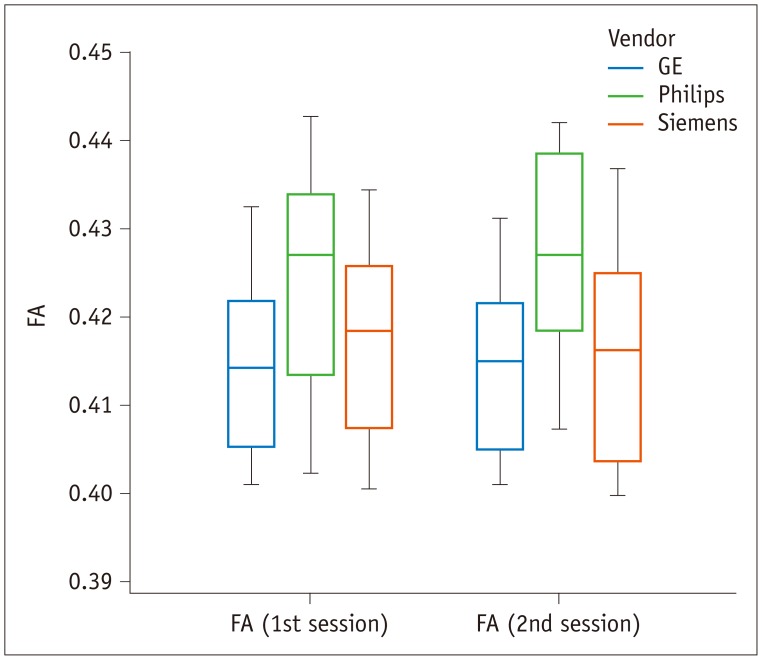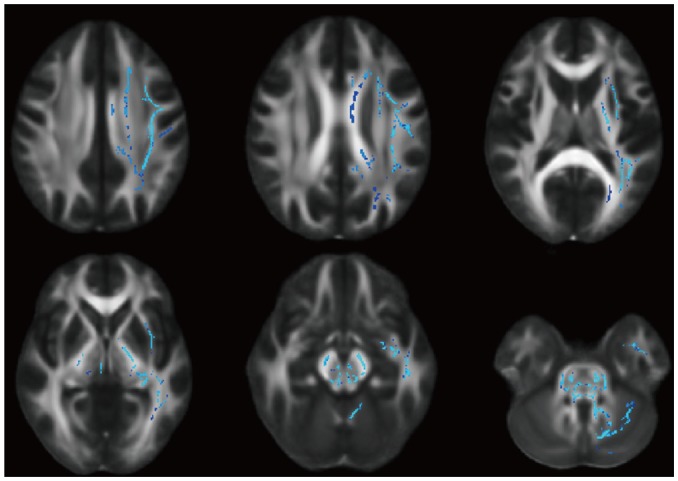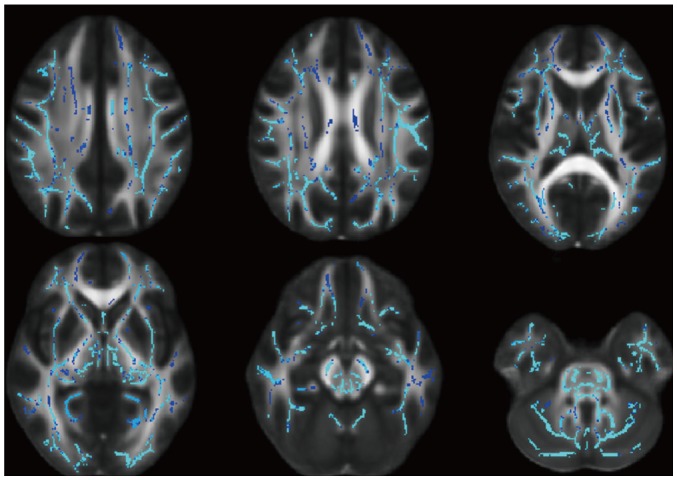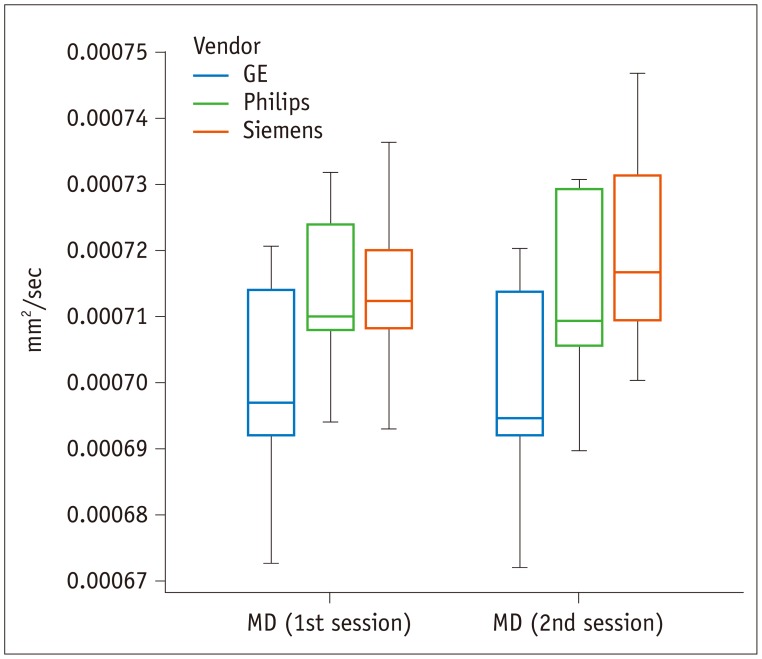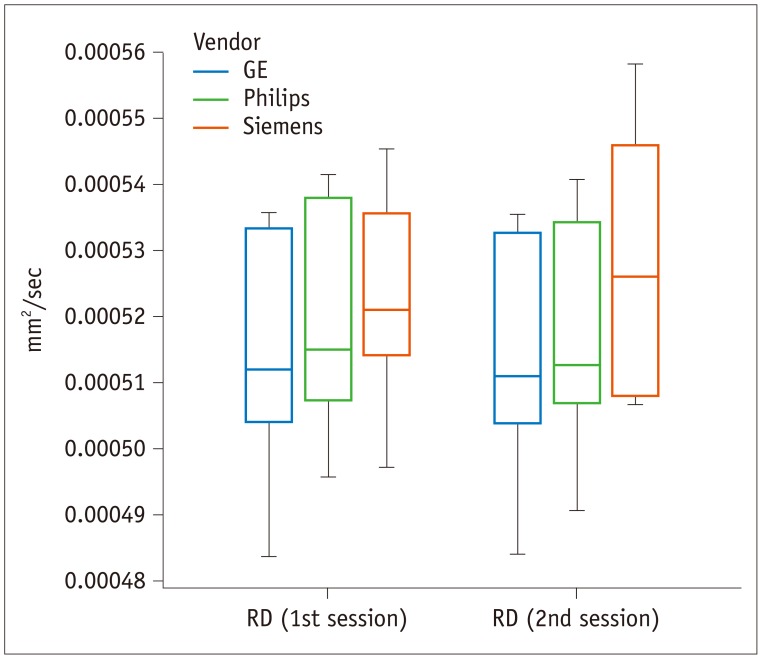Korean J Radiol.
2018 Aug;19(4):777-782. 10.3348/kjr.2018.19.4.777.
Inter-Vendor and Inter-Session Reliability of Diffusion Tensor Imaging: Implications for Multicenter Clinical Imaging Studies
- Affiliations
-
- 1Department of Radiology, Konkuk University Medical Center, Konkuk University School of Medicine, Seoul 05030, Korea. mdmoonwj@kuh.ac.kr
- 2Department of Radiology, Kyunghee University, Seoul 05278, Korea.
- KMID: 2413707
- DOI: http://doi.org/10.3348/kjr.2018.19.4.777
Abstract
OBJECTIVE
To evaluate the inter-vendor and inter-session reliability of diffusion tensor imaging (DTI) and relevant parameters.
MATERIALS AND METHODS
This prospective study included 10 healthy subjects (5 women and 5 men; age range, 25-33 years). Each subject was scanned twice using 3T magnetic resonance scanners from three different vendors at two different sites. A voxel-wise statistical analysis of diffusion data was performed using Tract-Based Spatial Statistics. Fractional anisotropy (FA), mean diffusivity (MD), and radial diffusivity (RD) values were calculated for each brain voxel using FMRIB's Diffusion Toolbox.
RESULTS
A repeated measures analysis of variance revealed that there were no significant differences in FA values across the vendors or between sessions; however, there were significant differences in MD values between the vendors (p = 0.020). Although there were no significant differences in inter-session MD and inter-session/inter-vendor RD values, a significant group × factor interaction revealed differences in MD and RD values between the 1st and 2nd sessions conducted by the vendors (p = 0.004 and 0.006, respectively).
CONCLUSION
Although FA values exhibited good inter-vendor and inter-session reliability, MD and RD values did not show consistent results. Researchers using DTI should be aware of these limitations, especially when implementing DTI in multicenter studies.
MeSH Terms
Figure
Cited by 1 articles
-
Thyroid-Associated Orbitopathy: Evaluating Microstructural Changes of Extraocular Muscles and Optic Nerves Using Readout-Segmented Echo-Planar Imaging-Based Diffusion Tensor Imaging
Huan-Huan Chen, Hao Hu, Wen Chen, Dai Cui, Xiao-Quan Xu, Fei-Yun Wu, Tao Yang
Korean J Radiol. 2020;21(3):332-340. doi: 10.3348/kjr.2019.0053.
Reference
-
1. Oppenheim C, Rodrigo S, Poupon C, Dumas de la Roque A, Naggara O, Meder JF, et al. [Diffusion tensor MR imaging of the brain. Clinical applications]. J Radiol. 2004; 85:287–296. PMID: 15192520.2. Minati L, Grisoli M, Bruzzone MG. MR spectroscopy, functional MRI, and diffusion-tensor imaging in the aging brain: a conceptual review. J Geriatr Psychiatry Neurol. 2007; 20:3–21. PMID: 17341766.
Article3. Nucifora PG, Verma R, Lee SK, Melhem ER. Diffusion-tensor MR imaging and tractography: exploring brain microstructure and connectivity. Radiology. 2007; 245:367–384. PMID: 17940300.
Article4. Jovicich J, Marizzoni M, Bosch B, Bartrés-Faz D, Arnold J, Benninghoff J, et al. Multisite longitudinal reliability of tract-based spatial statistics in diffusion tensor imaging of healthy elderly subjects. Neuroimage. 2014; 101:390–403. PMID: 25026156.
Article5. Laganà M, Rovaris M, Ceccarelli A, Venturelli C, Marini S, Baselli G. DTI parameter optimisation for acquisition at 1.5T: SNR analysis and clinical application. Comput Intell Neurosci. 2010; 254032. PMID: 20069121.
Article6. Teipel SJ, Reuter S, Stieltjes B, Acosta-Cabronero J, Ernemann U, Fellgiebel A, et al. Multicenter stability of diffusion tensor imaging measures: a European clinical and physical phantom study. Psychiatry Res. 2011; 194:363–371. PMID: 22078796.
Article7. Grech-Sollars M, Hales PW, Miyazaki K, Raschke F, Rodriguez D, Wilson M, et al. Multi-centre reproducibility of diffusion MRI parameters for clinical sequences in the brain. NMR Biomed. 2015; 28:468–485. PMID: 25802212.8. Vollmar C, O'Muircheartaigh J, Barker GJ, Symms MR, Thompson P, Kumari V, et al. Identical, but not the same: intra-site and inter-site reproducibility of fractional anisotropy measures on two 3.0T scanners. Neuroimage. 2010; 51:1384–1394. PMID: 20338248.
Article9. Tofts PS, Collins DJ. Multicentre imaging measurements for oncology and in the brain. Br J Radiol. 2011; 84(Spec No 2):S213–S226. PMID: 22433831.
Article10. Kamagata K, Shimoji K, Hori M, Nishikori A, Tsuruta K, Yoshida M, et al. Intersite reliability of diffusion tensor imaging on two 3T scanners. Magn Reson Med Sci. 2015; 14:227–233. PMID: 25740241.
Article11. Pagani E, Hirsch JG, Pouwels PJ, Horsfield MA, Perego E, Gass A, et al. Intercenter differences in diffusion tensor MRI acquisition. J Magn Reson Imaging. 2010; 31:1458–1468. PMID: 20512899.
Article12. Fox RJ, Sakaie K, Lee JC, Debbins JP, Liu Y, Arnold DL, et al. A validation study of multicenter diffusion tensor imaging: reliability of fractional anisotropy and diffusivity values. AJNR Am J Neuroradiol. 2012; 33:695–700. PMID: 22173748.
Article13. Magnotta VA, Matsui JT, Liu D, Johnson HJ, Long JD, Bolster BD Jr, et al. Multicenter reliability of diffusion tensor imaging. Brain Connect. 2012; 2:345–355. PMID: 23075313.
Article14. Villemagne VL, Kim SY, Rowe CC, Iwatsubo T. Imago mundi, imago AD, imago ADNI. Alzheimers Res Ther. 2014; 6:62. PMID: 25478022.
Article15. Smith SM. Fast robust automated brain extraction. Hum Brain Mapp. 2002; 17:143–155. PMID: 12391568.
Article16. Behrens TE, Woolrich MW, Jenkinson M, Johansen-Berg H, Nunes RG, Clare S, et al. Characterization and propagation of uncertainty in diffusion-weighted MR imaging. Magn Reson Med. 2003; 50:1077–1088. PMID: 14587019.
Article17. Jones RG, Payne RB. Clinical investigation and statistics in laboratory medicine. London: ACB Venture Publications;1997.18. Anderson AW. Theoretical analysis of the effects of noise on diffusion tensor imaging. Magn Reson Med. 2001; 46:1174–1188. PMID: 11746585.
Article
- Full Text Links
- Actions
-
Cited
- CITED
-
- Close
- Share
- Similar articles
-
- Principle and Experiments in Diffusion Tensor Imaging
- Diffusion Tensor Imaging: Exploring the Motor Networks and Clinical Applications
- Mini-Review of Studies Reporting the Repeatability and Reproducibility of Diffusion Tensor Imaging
- Multi-slice Multi-echo Pulsed-gradient Spin-echo (MePGSE) Sequence for Diffusion Tensor Imaging MRI: A Preliminary Result
- Intracranial Hemorrhage in the Corpus Callosum Presenting as Callosal Disconnection Syndrome: FDG-PET and Tractography: A Case Report

